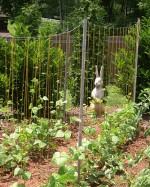 Space is often a limiting factor in the vegetable garden. Many plants like squash, need a lot of room, and a crop of corn needs even more. One of the solutions to the space problem is growing crops vertically. Some plants, like tomatoes, are commonly grown as pillars as long as you supply them with cages or supports. Many other vegetables are not commonly grown vertically but could be.
Space is often a limiting factor in the vegetable garden. Many plants like squash, need a lot of room, and a crop of corn needs even more. One of the solutions to the space problem is growing crops vertically. Some plants, like tomatoes, are commonly grown as pillars as long as you supply them with cages or supports. Many other vegetables are not commonly grown vertically but could be.
If space is a problem consider some of these candidates for vertical gardening.
 Pole Beans
Pole Beans
Rather than grow bush beans, consider pole beans. Provide a trellis or tepee and the beans will shoot upward and cover it. Each plant can produce about 10 times more beans than a bush bean and does so over the whole growing season if the beans are harvested regularly.
-
Height: To 15’
Propagation: Direct sown seeds (plants resent being transplanted)
Problems: Cutworms, Japanese beetles, powdery mildew
Hardiness: Zones 4-11 as annual
Recommended Varieties: Kentucky Wonder,‘Blue Lake’, ‘Romano’
 Cucumbers
Cucumbers
Cucumbers have tendrils and are naturally climbers although most people seem to let them sprawl all over the ground. There are two types of cucumbers commonly grown, slicers and picklers (but both types can be used for either purpose). The slicers are less prolific and heavier than the picklers, and will need a stronger support.
-
Height: Up to 10’ depending on the variety
Propagation: Direct-sown seed; can be started indoors 4 weeks before outdoor planting
Problems: Cucumber beetles (spread cucumber wilt), powdery mildew,
Hardiness: Zones 5-11 as annual
Recommended Varieties: ‘Marketmore 76’ (slicer), ‘Oriental Express Burpless Hybrid’ (slicer up to 14” long), ‘Country Fair’ (pickler)
 Malabar Spinach
Malabar Spinach
The dark green heart shaped leaves of the fast-growing are a good substitute for regular spinach. It tolerates heat and humidity so can be grown for a longer season than regular spinach which is a cool weather crop. You can start to harvest lightly in about 50 days. As leaves are harvested, new ones are produced so that spinach is available through the summer. The stems are red and the flowers pink so the plants make an attractive as well as tasty addition to the garden. New Zealand spinach is also a good candidate for vertical gardening, growing up to 4’ and being equally heat-resistant.
-
Height: 10’
Propagation: Direct sown seed; can be started indoors 4 weeks before planting out
Problems: Slugs
Hardiness: Zones 4-11 as annual
 Climbing Zucchini
Climbing Zucchini
True, most summer squash are bushy plants but there are some that climb. The weight of the fruit requires a strong trellis to hold the plant up.
-
Height: Up to 8’
Propagation: Direct seed; seed may be started indoors 4 weeks before planting out
Problems: Borers, powdery mildew
Hardiness: Zones 5-11
Recommended Varieties: ‘Black Forest’, ‘Trombone’ (Italian heirloom also known as ‘Zucchino Rampicante’)
 English Peas
English Peas
English peas may be short and require no staking, or tall (to 6’). They are lighter than pole beans and so can grow on twiggy branches, bamboo canes, and similar supports. Peas are a cool weather crop and can be planted several weeks before the last frost date. They can be harvested about two months later so allow a warm weather crop to be planted in its place.
-
Height: Up to 6’
Propagation: Direct sown seed; may be started indoors 4 weeks before planting out
Problems: Aphids, powdery mildew
Hardiness: Zones 4-10 as cool weather crop
Recommended Varieties: ‘Green Arrow’ (shell pea), ‘Melting Sugar’ (edible pod), ‘Alaska’ (heavy yielding, good for South)
By growing some vegetables like these vertically you can make more room for some plants like peppers, eggplants, and lettuce, that can’t be grown vertically. If you like the idea of gardening vertically you might want to try growing lettuce, onion, beets, and carrots in tower pots consisting of tiered shelves or holders that support individual containers. Once you start gardening vertically you will find more ways to save space and that means more plants for the vegetable garden.
